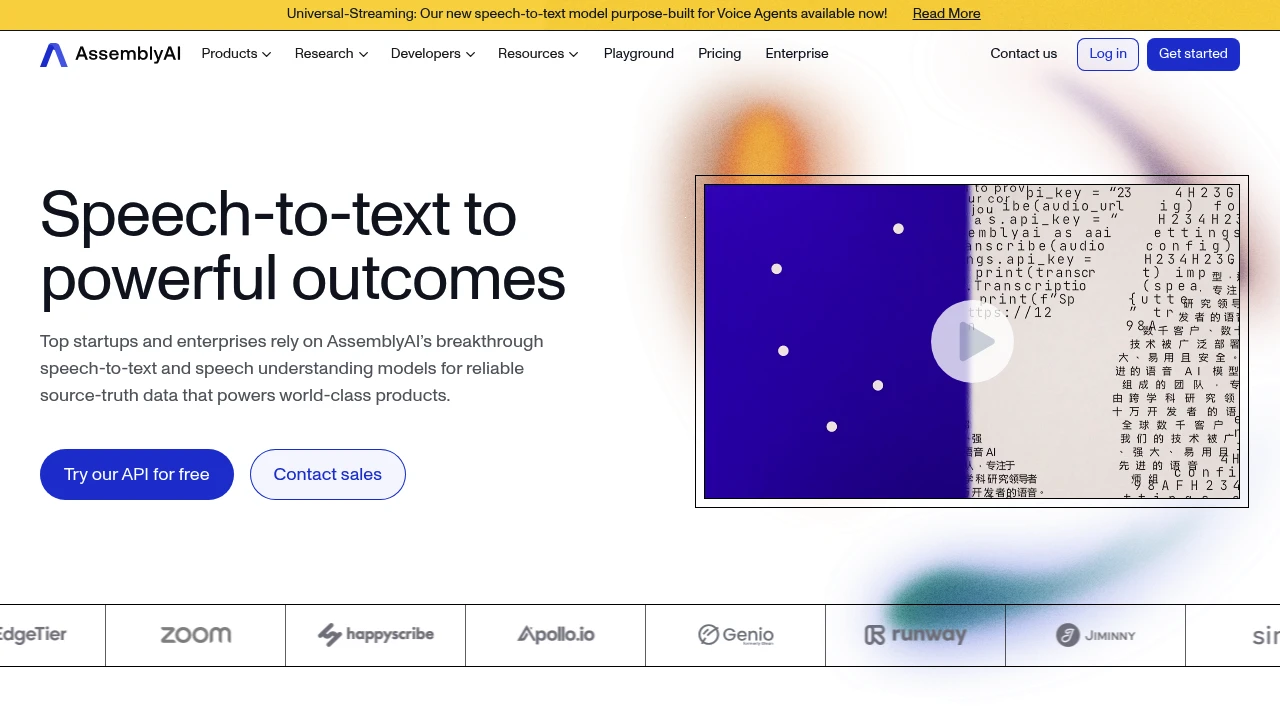AssemblyAI
AssemblyAI provides APIs for transcription, speech recognition, and audio intelligence to power voice-enabled products.

AssemblyAI Features & Overview
AssemblyAI is a speech intelligence platform for developers and media teams. It transcribes streams and files, then layers diarization, PII redaction, sentiment, topics, and summaries so apps gain searchable text and actionable signals. You upload or stream audio, receive word-level timestamps and confidence scores, and subscribe to webhooks for completion. SDKs, streaming sockets, and a single REST surface let you add transcription and audio intelligence without standing up separate services.
Core Features
- Automatic Speech Recognition: Convert audio and video to text with word-level timestamps and confidence per token. Configure language hints and domain boosts to improve accuracy on brands, jargon, and acronyms.
- Streaming Transcription: Send audio frames over WebSocket and receive partial and final results in near real time. Use sequence numbers and time offsets to align captions with players and live dashboards.
- Speaker Diarization: Separate speakers with turn boundaries and confidence. Retrieve speaker labels at the utterance level and merge adjacent segments to keep transcripts readable for long meetings or podcasts.
- Content Safety and PII Redaction: Detect sensitive categories and optionally mask or drop PII such as names, emails, and card numbers. Receive offsets for redaction so you can bleep audio or blur captions precisely.
- Sentiment and Topic Detection: Classify utterances as positive, neutral, or negative and tag conversations with high-level topics. Store both signals with timestamps to analyze call quality, moments, and campaign themes.
- Summarization and Chapters: Generate abstractive summaries and auto-chapters with titles and timecodes. Present a table of contents for long recordings and use summaries to power highlights, notes, and search previews.
- Entity and Keyword Extraction: Pull people, places, organizations, and custom keywords with character spans. Link entities to knowledge bases and use keywords to trigger workflows like ticket routing or CRM updates.
- Custom Vocabulary and Boosting: Submit term lists and pronunciations to raise recognition accuracy for products and proper nouns. Scope boosts per request to avoid degrading general performance in other domains.
- File Ingest and Large Media Support: Upload files or pass remote URLs with retry and chunked transfer. The API handles long recordings and variable sample rates while returning consistent JSON across formats.
- Webhooks and Job Status: Register callback URLs for completion and intermediate states. Include your correlation IDs to tie transcripts back to originals and retry failed deliveries with exponential backoff.
- SDKs and Developer Tooling: Use Python and Node SDKs, typed responses, and code samples for common tasks. Local CLIs help test requests, inspect payloads, and replay edge cases before you ship.
- Security and Governance: Control data retention, mask sensitive text, and restrict project keys by environment. Enterprise options add SSO, audit logs, and regional processing for teams with stricter policies.
Supported Platforms / Integrations
- REST API and WebSocket streaming
- SDKs for Python and JavaScript
- Webhooks for async job completion
- Cloud storage ingest from URLs and signed uploads
- Common media formats including MP3, WAV, M4A, MP4
- Data export to warehouses and search indexes
Use Cases & Applications
- Media and podcast publishers generating captions, chapters, and show notes
- Contact centers analyzing calls for sentiment, topics, and compliance flags
- Edtech platforms turning lectures into searchable notes and key takeaways
- Product teams adding speech features to apps, bots, and analytics
Pricing
- Free: $0 for testing with limited minutes
- Pay as you go: usage-based per minute
- Scale: volume discounts for higher throughput
- Enterprise: contact sales
Why You’d Love It
- One API for transcription plus rich audio intelligence
- Real-time and batch workflows that fit live or offline content
- Clear JSON outputs with timestamps for precise UX and analytics
Pros & Cons
Pros
- Accurate transcripts with strong diarization, redaction, and insights
- Straightforward API surface, SDKs, and webhooks for fast integration
- Features that replace multiple point tools in the audio pipeline
Cons
- Large catalogs can drive significant usage spend
- Custom terms need tuning to balance boosts and general accuracy
Conclusion AssemblyAI gives your product clean transcripts and practical intelligence signals from the same API. You handle live streams and backfiles, enrich text with topics and summaries, and protect users with redaction and safety checks. Teams ship speech features quickly and keep data actionable.